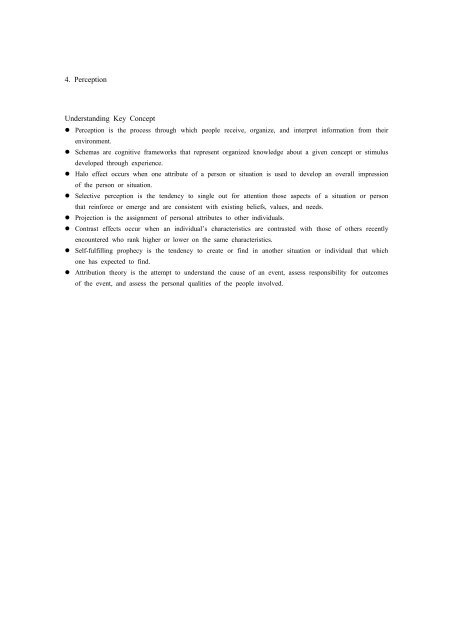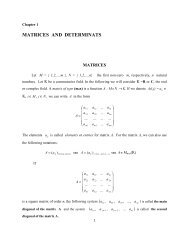4. Perception Understanding Key Concept - Uuooidata.org
4. Perception Understanding Key Concept - Uuooidata.org
4. Perception Understanding Key Concept - Uuooidata.org
You also want an ePaper? Increase the reach of your titles
YUMPU automatically turns print PDFs into web optimized ePapers that Google loves.
<strong>4.</strong> <strong>Perception</strong><strong>Understanding</strong> <strong>Key</strong> <strong>Concept</strong>l <strong>Perception</strong> is the process through which people receive, <strong>org</strong>anize, and interpret information from theirenvironment.l Schemas are cognitive frameworks that represent <strong>org</strong>anized knowledge about a given concept or stimulusdeveloped through experience.l Halo effect occurs when one attribute of a person or situation is used to develop an overall impressionof the person or situation.l Selective perception is the tendency to single out for attention those aspects of a situation or personthat reinforce or emerge and are consistent with existing beliefs, values, and needs.l Projection is the assignment of personal attributes to other individuals.l Contrast effects occur when an individual’s characteristics are contrasted with those of others recentlyencountered who rank higher or lower on the same characteristics.l Self-fulfilling prophecy is the tendency to create or find in another situation or individual that whichone has expected to find.l Attribution theory is the attempt to understand the cause of an event, assess responsibility for outcomesof the event, and assess the personal qualities of the people involved.
The Perceptual ProcessA spectacular completed pass during the 1982 National Football Conference championship gamehelped propell Joe Montana, former San Francisco 49er quarterback, into the legendary status heenjoys today. The reverse effect apparently occurred for Danny White, Dallas Cowboys’quarterback. He fumbled in the final minute of the same game and never obtained the status ofhis predecessor, Roger Stauback, even though White took the Cowboys to the championshipgame three years in a row.This example illustrates the notion of perception, the process by which people select, <strong>org</strong>anize,interpret, retrieve, and respond to information from the world around them. This information isgathered from the five senses of sight, hearing, touch, taste, and smell. As Montana, White, andStauback can attest, perception and reality are not necessarily the same thing. The perceptions orresponses of any two people are also not necessarily identical, even when they are describing thesame event.Through perception, people process information inputs into responses involving feelings andaction. <strong>Perception</strong> is a way of forming impressions about oneself, other people, and daily lifeexperiences. It also serves as a screen or filter through which information passes before it has aneffect on people. The quality or accuracy of a person’s perceptions, therefore, has a majorimpact on his or her responses to a given situation.Perceptual responses are also likely to vary between managers and subordinates. Consider Figure1.11, which depicts contrasting perceptions of a performance appraisal between managers andsubordinates. Rather substantial differences exist in the two sets of perceptions; the responses canbe significant. In this case, managers who perceive that they already give adequate attention topast performance, career development, and supervisory help are unlikely to give greater emphasisto these points in future performance appraisal interviews. In contrast, their subordinates arelikely to experience continued frustration because they perceive that these subjects are not beinggiven sufficient attention.FACTORS INFLUENCING THE PERCEPTUAL PROCESSThe factors that contribute to perceptual differences and the perceptual process among people atwork are summarized in Figure 1.12 and include characteristics of the perceiver, the setting, andthe perceived.The Perceiver A person’s past experiences, needs or motives, personality, and values andattitudes may all influence the perceptual process. A person with a strong achievement need
tends to perceive a situation in terms of that need. If you see doing well in class as a way tohelp meet your achievement need, for example, you will tend to emphasize that aspect whenconsidering various classes. By the same token, a person with a negative attitude toward unionsmay look for antagonisms even when local union officials make routine visits to the<strong>org</strong>anization. These and other perceiver factors influence the various aspects of the perceptualprocess.The Setting The physical, social, and <strong>org</strong>anizational context of the perceptual setting also caninfluence the perceptual process. Kim Jeffrey, the recently appointed CEO of Nestle’s Perrier,was perceived by his subordinates as a frightening figure when he gave vent to his temper andhad occasional confrontations with them. In the previous setting, before he was promoted,Jeffrey’s flare-ups had been tolerable; now they caused intimidation, so his subordinates feared toexpress their opinions and recommendations. Fortunately, after he received feedback about thisproblem, he was able to change his subordinates’ perceptions in the new setting.The Perceived Characteristics of the perceived person, object, or event, such as contrast, intensity,figure–ground separation, size, motion, and repetition or novelty, are also important in theperceptual process. For example, one mainframe computer among six PCs or one man among sixwomen will be perceived differently than one of six mainframe computers or one of six men—-where there is less contrast. Intensity can vary in terms of brightness, color, depth, sound, andthe like. A bright red sports car stands out from a group of gray sedans; whispering or shoutingstands out from ordinary conversation. The concept is known as figure–ground separation, and itdepends on which image is perceived as the background and which as the figure. For anillustration, look at Figure 1.13. What do you see? Faces or a vase?In the matter of size, very small or very large people tend to be perceived differently and morereadily than average-sized people. Similarly, in terms of motion, moving objects are perceiveddifferently from stationary objects. And, of course, advertisers hope that ad repetition orfrequency will positively influence peoples’ perception of a product. Television advertising blitzesfor new models of personal computers are a case in point. Finally, the novelty of a situationaffects its perception. A purple-haired teenager is perceived differently from a blond or abrunette, for example.STAGES OF THE PERCEPTUAL PROCESSSo far we have discussed key factors influencing the perceptual process. Now we’ll look at thestages involved in processing the information that ultimately determines a person’s perception andreaction, as shown in Figure 1.1<strong>4.</strong> The infor-mation-processing stages are divided into information
attention and selection; <strong>org</strong>anization of information; information interpretation; and informationretrieval.Attention and Selection Our senses are constantly bombarded with so much information that ifwe don’t screen it, we quickly become incapacitated with information overload. Selectivescreening lets in only a tiny proportion of all of the information available. Some of theselectivity comes from controlled processing—-consciously deciding what information to payattention to and what to ignore. In this case, the perceivers are aware that they are processinginformation. Think about the last time you were at a noisy restaurant and screened out all thesounds but those of the person with whom you were talking.In contrast to controlled processing, screening can also take place without the perceiver’sconscious awareness. For example, you may drive a car without consciously thinking about theprocess of driving; you may be thinking about a problem you are having with your course workinstead. In driving the car, you are affected by information from the world around you, such astraffic lights and other cars, but you don’t pay conscious attention to that information. Suchselectivity of attention and automatic information processing works well most of the time whenyou drive, but if a nonroutine event occurs, such as an animal darting into the road, you mayhave an accident unless you quickly shift to controlled processing.Organization Even though selective screening takes place in the attention stage, it is stillnecessary to find ways to <strong>org</strong>anize the information efficiently. Schemas help us do this. Schemasare cognitive frameworks that represent <strong>org</strong>anized knowledge about a given concept or stimulusdeveloped through experience. A self schema contains information about a person’s ownappearance, behavior, and personality. For instance, a person with a decisiveness schema tends toperceive himself or herself in terms of that aspect, especially in circumstances calling forleadership.Person schemas refer to the way individuals sort others into categories, such as types or groups,in terms of similar perceived features. The term prototype, or stereotype, is often used torepresent these categories; it is an abstract set of features commonly associated with members ofthat category. Once the prototype is formed, it is stored in long-term memory; it is retrievedwhen it is needed for a comparison of how well a person matches the prototype’s features. Forinstance, you may have a “good worker” prototype in mind, which includes hard work,intelligence, punctuality, articulateness, and decisiveness; that prototype is used as a measureagainst which to compare a given worker. Stereotypes may be regarded as prototypes based onsuch demographic characteristics as gender, age, able-bodiedness, and racial and ethnic groups.
A script schema is defined as a knowledge framework that describes the appropriate sequence ofevents in a given situation. For example, an experienced manager would use a script schema tothink about the appropriate steps involved in running a meeting. Finally, person-in-situationschemas combine schemas built around persons (self and person schemas) and events (scriptschemas). Thus, a manager might <strong>org</strong>anize his or her perceived information in a meeting arounda decisiveness schema for both himself or herself and a key participant in the meeting. Here, ascript schema would provide the steps and their sequence in the meeting; the manager wouldpush through the steps decisively and would call on the selected participants periodicallythroughout the meeting to respond decisively. Note that, although this approach might facilitate<strong>org</strong>anization of important information, the perceptions of those attending might not be completelyaccurate because decisiveness of the person-in-situation schema did not allow the attendeesenough time for open discussion.As you can see in Figure 1.14, schemas are not important just in the <strong>org</strong>anizing stage; they alsoaffect other stages in the perception process. Furthermore, schemas rely heavily on automaticprocessing to free people up to use controlled processing as necessary. Finally, as we will show,the perceptual factors described earlier, as well as the distortions, to be discussed shortly,influence schemas in various ways.Interpretation Once your attention has been drawn to certain stimuli and you have grouped or<strong>org</strong>anized this information, the next step is to uncover the reasons behind the actions. That is,even if your attention is called to the same information and you <strong>org</strong>anize it in the same wayyour friend does, you may interpret it differently or make different attributions about the reasonsbehind what you have perceived. For example, as a manager, you might attribute complimentsfrom a friendly subordinate to his being an eager worker, whereas your friend might interpret thebehavior as insincere flattery.Retrieval So far, we have discussed the stages of the perceptual process as if they all occurredat the same time. However, to do so ignores the important component of memory. Each of theprevious stages forms part of that memory and contributes to the stimuli or information storedthere. The information stored in our memory must be retrieved if it is to be used. This leads usto the retrieval stage of the perceptual process summarized in Figure 1.1<strong>4.</strong>All of us at times can’t retrieve information stored in our memory. More commonly, ourmemory decays, so that only some of the information is retrieved. Schemas play an importantrole in this area. They make it difficult for people to remember things not included in them. For
example, based on your prototype about the traits comprising a “high performing employee”(hard work, punctuality, intelligence, articulateness, and decisiveness), you may overestimate thesetraits and underestimate others when you are evaluating the performance of a subordinate whomyou generally consider good. Thus, you may overestimate the person’s decisiveness since it is akey part of your high performance prototype.Indeed, people are as likely to recall nonexistent traits as they are to recall those that are reallythere. Furthermore, once formed, prototypes may be difficult to change and tend to last a longtime. Obviously, this distortion can cause major problems in terms of performance appraisals andpromotions, not to mention numerous other interactions on and off the job. By the same token,such prototypes allow you to “chunk” information and reduce overload. Thus, prototypes are adouble-edged sword.RESPONSE TO THE PERCEPTUAL PROCESSThroughout this chapter, we have shown how the perceptual process influences numerous OBresponses. Figure 1.14 classifies such responses into thoughts and feelings and actions. Forexample, in countries such as Mexico, bosses routinely greet their secretaries with a kiss, andthat is expected behavior. In contrast, in this country your thoughts and feelings might be quitedifferent about such behavior. You might very well perceive this as a form of sexual harassment.As you cover the other OB topics in the book, you also should be alert to the importance ofperceptual responses covering thoughts, feelings, and actions.Common Perceptual DistortionsFigure 1.15 shows some common kinds of distortions that can make the perceptual processinaccurate and affect the response. These are stereotypes and prototypes, halo effects, selectiveperception, projection, contrast effects, and self-fulfilling prophecy.STEREOTYPES OR PROTOTYPESEarlier, when discussing person schemas, we described stereotypes, or prototypes, as useful waysof combining information in order to deal with information overload. At the same time, wepointed out how stereotypes can cause inaccuracies in retrieving information, along with somefurther problems. In particular, stereotypes obscure individual differences; that is, they can preventmanagers from getting to know people as individuals and from accurately assessing their needs,preferences, and abilities. We compared these stereotypes with research results and showed theerrors that can occur when stereotypes are relied on for decision making. Nevertheless,stereotypes continue to exist at the board of directors level in <strong>org</strong>anizations. A recent survey
from 133 Fortune 500 firms showed that female directors were favored for membership on onlythe relatively peripheral public affairs committee in these <strong>org</strong>anizations. Males were favored formembership on the more important compensation, executive, and finance committee, even whenthe females were equally or more experienced than their male counterparts.Here, we reiterate our previous message: Both managers and employees need to be sensitive tostereotypes; they also must attempt to overcome them and recognize that an increasingly diverseworkforce can be a truly competitive advantage.HALO EFFECTSA halo effect occurs when one attribute of a person or situation is used to develop an overallimpression of the individual or situation. Like stereotypes, these distortions are more likely tooccur in the <strong>org</strong>anization stage of perception. Halo effects are common in our everyday lives.When meeting a new person, for example, a pleasant smile can lead to a positive firstimpression of an overall “warm” and “honest” person. The result of a halo effect is the same asthat associated with a stereotype, however: Individual differences are obscured.Halo effects are particularly important in the performance appraisal process because they caninfluence a manager’s evaluations of subordinates’ work performance. For example, people withgood attendance records tend to be viewed as intelligent and responsible; those with poorattendance records are considered poor performers. Such conclusions may or may not be valid. Itis the manager’s job to try to get true impressions rather than allowing halo effects to result inbiased and erroneous evaluations.SELECTIVE PERCEPTIONSelective perception is the tendency to single out those aspects of a situation, person, or objectthat are consistent with one’s needs, values, or attitudes. Its strongest impact occurs in theattention stage of the perceptual process. This perceptual distortion is identified in a classicresearch study involving executives in a manufacturing company. When asked to identify the keyproblem in a comprehensive business policy case, each executive selected problems consistentwith his or her functional area work assignments. For example, most marketing executivesviewed the key problem area as sales, whereas production people tended to see the problem asone of production and <strong>org</strong>anization. These differing viewpoints would affect how the executivewould approach the problem; they might also create difficulties once these people tried to worktogether to improve things.More recently, 121 middle- and upper-level managers attending an executive development
program expressed broader views in conjunction with an emphasis on their own function. Forexample, a chief financial officer indicated an awareness of the importance of manufacturing, andan assistant marketing manager recognized the importance of accounting and finance along withtheir own functions. Thus, this more current research demonstrated very little perceptualselectivity. The researchers were not, however, able to state definitively what accounted for thediffering results.These results suggest that selective perception is more important at some times than at others.Managers should be aware of this characteristic and test whether or not situations, events, orindividuals are being selectively perceived. The easiest way to do this is to gather additionalopinions from other people. When these opinions contradict a manager’s own, an effort shouldbe made to check the original impression.PROJECTIONProjection is the assignment of one’s personal attributes to other individuals; it is especiallylikely to occur in the interpretation stage of perception. A classic projection error is illustrated bymanagers who assume that the needs of their subordinates and their own coincide. Suppose, forexample, that you enjoy responsibility and achievement in your work. Suppose, too, that you arethe newly appointed manager of a group whose jobs seem dull and routine. You may movequickly to expand these jobs to help the workers achieve increased satisfaction from morechallenging tasks because you want them to experience things that you, personally, value inwork. But this may not be a good decision. If you project your needs onto the subordinates,individual differences are lost. Instead of designing the subordinates’ jobs to fit their needs best,you have designed their jobs to fit your needs. The problem is that the subordinates may bequite satisfied and productive doing jobs that seem dull and routine to you. Projection can becontrolled through a high degree of self-awareness and empathy—the ability to view a situationas others see it. In contrast with the usual negative effects of projection just described, theresometimes can be a positive ethical impact.CONTRAST EFFECTSEarlier, when discussing the perceived, we mentioned how a red sports car would stand out fromothers because of its contrast. Here, we show the perceptual distortion that can occur when, say,a person gives a talk following a strong speaker or is interviewed for a job following a seriesof mediocre applicants. We can expect a contrast effect to occur when an individual’scharacteristics are contrasted with those of others recently encountered who rank higher or loweron the same characteristics. Clearly, both managers and employees need to be aware of thepossible perceptual distortion the contrast effect may create in many work settings.
SELF-FULFILLING PROPHECYA final perceptual distortion that we consider is the self-fulfilling prophecy—the tendency tocreate or find in another situation or individual that which you expected to find in the firstplace. Self-fulfilling prophecy is sometimes referred to as the “Pygmalion effect,” named for amythical Greek sculptor who created a statue of his ideal mate and then made her come to life.His prophecy came true! Through self-fulfilling prophecy, you also may create in the worksituation that which you expect to find.Self-fulfilling prophecy can have both positive and negative results for you as a manager.Suppose you assume that your subordinates prefer to satisfy most of their needs outside the worksetting and want only minimal involvement with their jobs. Consequently, you are likely toprovide simple, highly structured jobs designed to require little involvement. Can you predictwhat response the subordinates would have to this situation? Their most likely response would beto show the lack of commitment you assumed they would have in the first place. Thus, yourinitial expectations are confirmed as a self-fulfilling prophecy.Self-fulfilling prophecy can have a positive side, however (see The Effective Manager 1.4).Students introduced to their teachers as “intellectual bloomers” do better on achievement teststhan do their counterparts who lack such a positive introduction. A particularly interestingexample of the self-fulfilling prophecy is that of Israeli tank crews. One set of tank commanderswas told that according to test data some members of their assigned crews had exceptionalabilities but others were only average. In reality, the crew members were assigned randomly, sothat the two test groups were equal in ability. Later, the commanders reportedthat the so-calledexceptional crew members performed better than the “average” members. As the study revealed,however, the commanders had paid more attention to and praised the crew members for whomthey had the higher expectancies. The self-fulfilling effects in these cases argue strongly formanagers to adopt positive and optimistic approaches to people at work.Managing the Perceptual ProcessTo be successful, managers must understand the perceptual process, the stages involved, and theimpact the perceptual process can have on their own and others’ responses. They must also beaware of what roles the perceiver, the setting, and the perceived have in the perceptual process.Particularly important with regard to the perceived is the concept of impression management—-forboth managers and others.
IMPRESSION MANAGEMENTImpression management is a person’s systematic attempt to behave in ways that will create andmaintain desired impressions in the eyes of others. First impressions are especially important andinfluence how people respond to one another. Impression management is influenced by suchactivities as associating with the “right people,” doing favors to gain approval, flattering others tomake oneself look better, taking credit for a favorable event, apologizing for a negative eventwhile seeking a pardon, agreeing with the opinions of others, downplaying the severity of anegative event, and doing favors for others. Successful managers learn how to use these activitiesto enhance their own images, and they are sensitive to their use by their subordinates and othersin their <strong>org</strong>anizations. In this context job titles are particularly important.DISTORTION MANAGEMENTDuring the attention and selection stage, managers should be alert to balancing automatic andcontrolled information processing. Most of their responsibilities, such as performance assessmentand clear communication, will involve controlled processing, which will take away from other jobresponsibilities. Along with more controlled processing, managers need to be concerned aboutincreasing the frequency of observations and about getting representative information rather thansimply responding to the most recent information about a subordinate or a production order, forinstance. Some <strong>org</strong>anizations, including large farms, have responded to the need for representativeand more accurate information by utilizing current technology. In addition, managers should notfail to seek out disconfirming information that will help provide a balance to their typicalperception of information.The various kinds of schemas and prototypes and stereotypes are particularly important at theinformation <strong>org</strong>anizing stage. Managers should strive to broaden their schemas or should evenreplace them with more accurate or complete ones.At the interpretation stage, managers need to be especially attuned to the impact of attribution oninformation; we discuss this concept further in the section on managing the attributional process.At the retrieval stage, managers should be sensitive to the fallibility of memory. They shouldrecognize the tendency to overrely on schemas, especially prototypes or stereotypes that may biasinformation stored and retrieved.Throughout the entire perception process managers should be sensitive to the informationdistortions caused by halo effects, selective perception, projection, contrast effects, andself-fulfilling prophecy, in addition to the distortions of stereotypes and prototypes.
Attribution TheoryEarlier in the chapter we mentioned attribution theory in the context of perceptual interpretation.Attribution theory aids in this interpretation by focusing on how people attempt to (1) understandthe causes of a certain event, (2) assess responsibility for the outcomes of the event, and (3)evaluate the personal qualities of the people involved in the event. In applying attribution theory,we are especially concerned with whether one’s behavior has been internally or externally caused.Internal causes are believed to be under an individual’s control—-you believe Jake’s performanceis poor because he is lazy. External causes are seen as outside a person—-you believe Kellie’sperformance is poor because her machine is old.According to attribution theory, three factors influence this internal or external determination:distinctiveness, consensus, and consistency. Distinctiveness considers how consistent a person’sbehavior is across different situations. If Jake’s performance is low, regardless of the machine onwhich he is working, we tend to give the poor performance an internal attribution; if the poorperformance is unusual, we tend to assign an external cause to explain it.Consensus takes into account how likely all those facing a similar situation are to respond in thesame way. If all the people using machinery like Kellie’s have poor performance, we tend togive her performance an external attribution. If other employees do not perform poorly, weattribute internal causation to her performance.Consistency concerns whether an individual responds the same way across time. If Jake has abatch of low-performance figures, we tend to give the poor performance an internal attribution.In contrast, if Jake’s low performance is an isolated incident, we attribute it to an externalcause.ATTRIBUTION ERRORSIn addition to these three influences, two errors have an impact on internal versus externaldetermination—-the fundamental attribution error and the self-serving bias. Figure 1.16 providesdata from a group of health-care managers. When supervisors were asked to identify, or attribute,causes of poor performance among their subordinates, the supervisors more often chose theindividual’s internal deficiencies—lack of ability and effort—-rather than external deficiencies inthe situation—-lack of support. This demonstrates a fundamental attribution error—-the tendency tounderestimate the influence of situational factors and to overestimate the influence of personalfactors in evaluating someone else’s behavior. When asked to identify causes of their own poor
performance, however, the supervisors overwhelmingly cited lack of support—-an external, orsituational, deficiency. This indicates a self-serving bias—-the tendency to deny personalresponsibility for performance problems but to accept personal responsibility for performancesuccess.To summarize, we tend to overemphasize other people’s internal personal factors in theirbehavior and to underemphasize external factors in other people’s behavior. In contrast, we tendto attribute our own success to our own internal factors and to attribute our failure to externalfactors.The managerial implications of attribution theory can be traced back to the fact that perceptionsinfluence responses. For example, a manager who feels that subordinates are not performing welland perceives the reason to be an internal lack of effort is likely to respond with attempts to“motivate” the subordinates to work harder; the possibility of changing external, situational factorsthat may remove job constraints and provide better <strong>org</strong>anizational support may be largelyignored. This oversight could sacrifice major performance gains. Interestingly, because of theself-serving bias, when they evaluated their own behavior, the supervisors in the earlier studyindicated that their performance would benefit from having better support. Thus, the supervisors’own abilities or willingness to work hard were not felt to be at issue.ATTRIBUTIONS ACROSS CULTURESResearch on the self-serving bias and fundamental attribution error has been done in culturesoutside the United States with unexpected results.115 In Korea, for example, the self-serving biaswas found to be negative; that is, Korean managers attribute work group failure to themselves—-“I was not a capable leader”—-rather than to external causes. In India, the fundamentalattribution error overemphasizes external rather than internal causes for failure. Africans attributenegative consequences—-driving away fish and angering mermaids into creating squalls—-towomen but apparently not to men. Why these various differences occurred is not clear, butdiffering cultural values appear to play a role. Finally, there is some evidence that U.S. femalesmay be less likely to emphasize the self-serving bias than males.Certain cultures, such as the United States, tend to overemphasize internal causes andunderemphasize external causes. Such overemphasis may result in negative attributions towardemployees. These negative attributions, in turn, can lead to disciplinary actions, negativeperformance evaluations, transfers to other departments, and over-reliance on training, rather thanfocusing on such external causes as lack of workplace support. Employees, too, take their cuesfrom managerial misattributions and, through negative self-fulfilling prophecies, may reinforce
managers’ original misattributions. Employees and managers alike (see The Effective Manager1.5) can be taught attributional realignment to help deal with such misattributions.
















